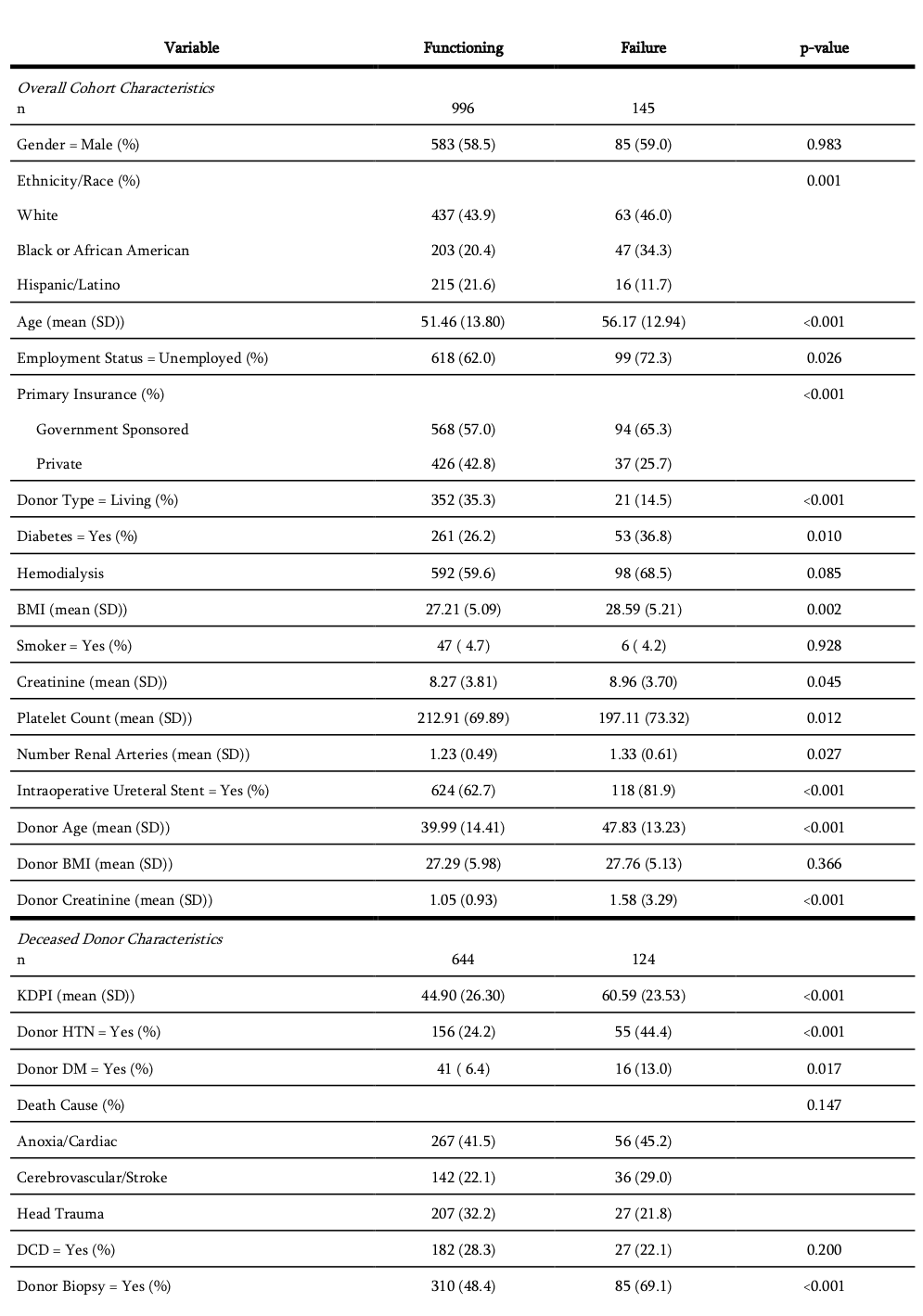Analyzing a pragmatic composite endpoint for 1-year kidney transplant outcomes: Patient loss, graft loss and eGFR less than 30. Results from NSQIP Transplant beta phase
Dominic Amara1, Hillary J. Braun2, Justin R. Parekh3, David P. Foley4, Peter G. Stock2, Stuart Greenstein5, Ryutaro Hirose2.
1School of Medicine, University of California, San Francisco, San Francisco, CA, United States; 2Department of Surgery, University of California, San Francisco, San Francisco, CA, United States; 3Department of Surgery, University of California, San Diego, San Diego, CA, United States; 4School of Medicine and Public Health, University of Wisconsin, Madison, WI, United States; 5Montefiore Einstein Center for Transplantation, Montefiore Medical Center, Albert Einstein College of Medicine, Bronx, NY, United States
Introduction: One-year graft survival after kidney transplantation approaches 94% in the United States. However, this metric fails to capture the impact of poorly-functioning grafts, and may overinflate the true success of kidney transplants. Lower eGFR 1 year after kidney transplant is associated with shorter graft and patient survival overall. Including eGFR as part of a composite endpoint with patient and graft survival may better estimate kidney transplant success. In order to improve transplant surgical quality, the American Society of Transplant Surgeons and American College of Surgeons initiated the National Surgical Quality Program (NSQIP) Transplant, which tracks post-transplant outcomes beyond basic graft and recipient survival. Now with 29 participating U.S. sites, we can evaluate the utility of a more pragmatic composite endpoint at 1 year for kidney transplant recipients.
Methods: Kidney transplant recipient-donor pairs from 2017-2019 with at least 1 year of follow-up were identified from the prospectively-collected NSQIP Transplant database. Each patient’s 1-year eGFR was estimated from the MDRD equation using patient demographics and creatine collected at 1-year. Patients met the composite endpoint if they experienced death, graft loss, or had an eGFR<30 mL/min/1.73 m2 at 1 year. Recipient and donor characteristics were analyzed. UV and MV logistic regression were performed to identify variables associated with meeting the composite endpoint.
Results: A total of 1,141 recipient-donor pairs were included, 145 (12.7%) of whom met the composite failure outcome: 41 (3.6%) died, 46 (4.0%) experienced graft loss, and 58 (5.1%) had an eGFR<30 at 1 year. Compared to patients that did not meet the failure endpoint, patients that did meet the endpoint were older, more often African-American, more often on public insurance and had higher BMIs. These patients also more often received intraoperative ureteral stents, as well as kidneys from deceased donors, from donors who were older, and from donors with higher creatinines (p<0.001 for all, Table). Deceased donor recipients who experienced failure received kidneys with a higher average KDPI and kidneys that were more likely to be biopsied (p<0.001 for both, Table).
In MV analysis, donor age, donor type and donor creatine, as well as use of intraoperative ureteral stents, number of renal arteries, and recipient BMI were significantly associated with composite failure. In the deceased donor recipients specifically, higher KDPI, stent use and recipient BMI were significant in the MV model.
Conclusion: Incorporating eGFR<30 as part of a composite metric may provide a more realistic appraisal of kidney transplant success at 1-year. Kidney quality, and technical surgical challenges, as represented through ureteral stent use and number of renal arteries, are significantly associated with success at 1-year. Recipient BMI may be a modifiable risk factor associated with success at 1 year.

[1] Parekh J, Ko C, Lappin J, Greenstein S, Hirose R: A Transplant-Specific Quality Initiative-Introducing TransQIP: A Joint Effort of the ASTS and ACS. Am J Transplant 17:1719-1722, 2017
[2] Parekh JR, Hirose R, Foley DP, Grieco A, Cohen ME, Hall BL, et al: Beyond death and graft survival-Variation in outcomes after kidney transplantation. Results from the NSQIP Transplant beta phase. Am J Transplant 19:2622-2630, 2019